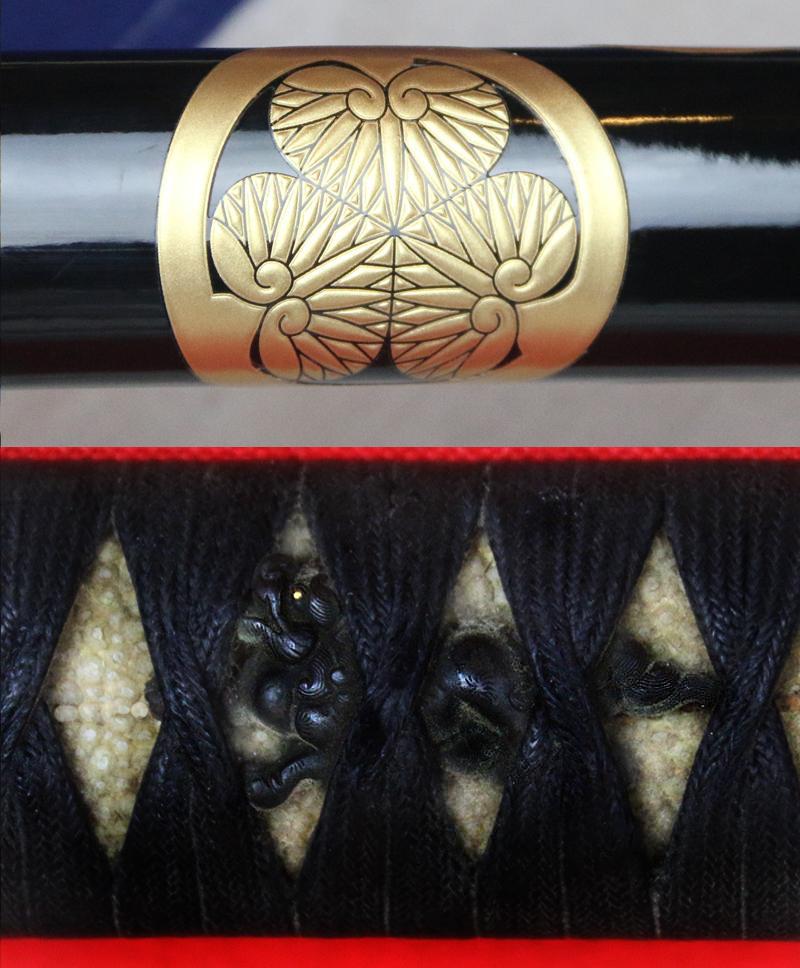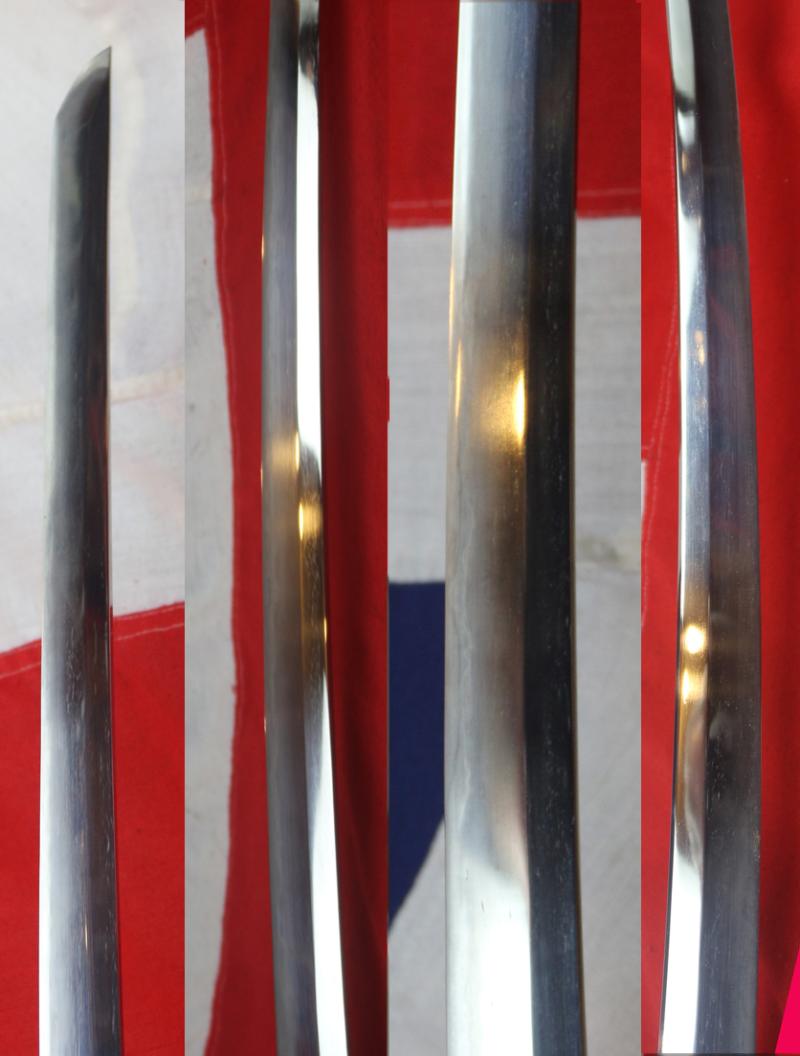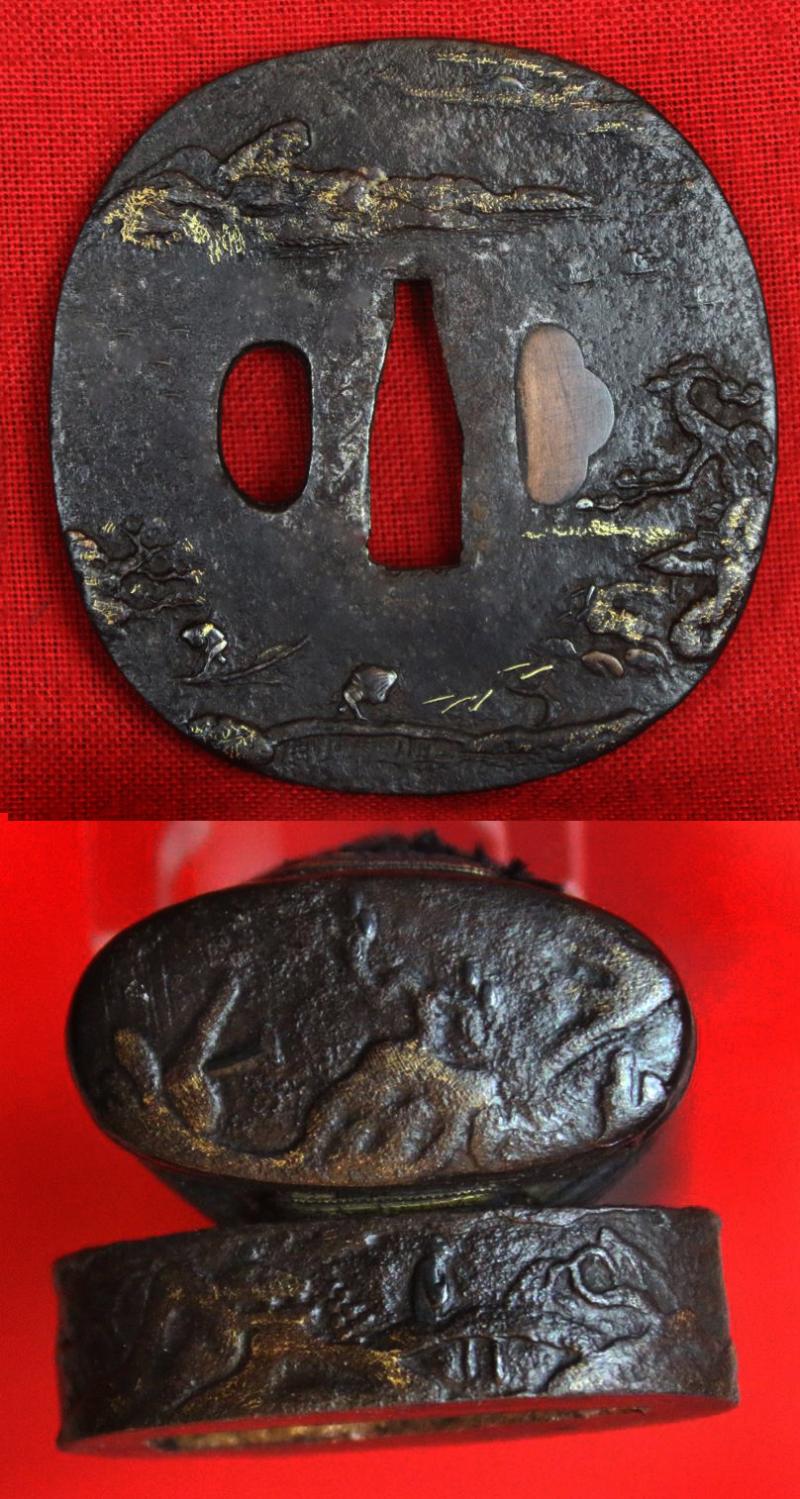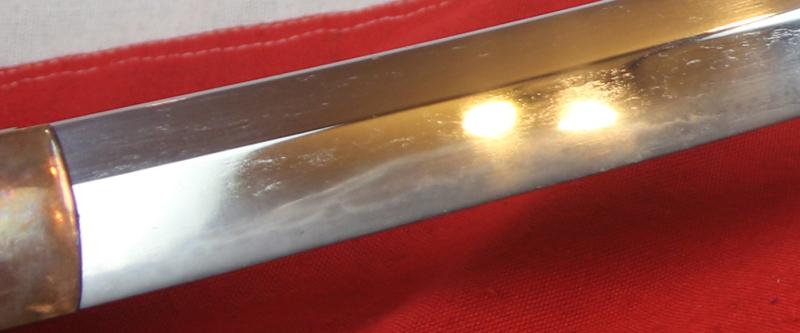A Superb, Ancient Koto Long Katana, Circa 1390 to1420 With a Very Fine Suite of Jakushi Iron & Gold Koshirae, A Signed Tsuba, and Matching Jukushi Fuchi-Kashira. The Stunning Black Saya Has Four Aoi Mon in Hiramaki-e Gold Lacquer of The Tokugawa
A 600 to 630 year old, long and mighty blade, of 29 inches, measured from the tsuba to tip in beautiful condition, with a fabulous hamon. This is a most impressive ancient sword from the great warring period of Japan Samurai endured for almost 700 years, from 1185 to 1867. Samurai families were considered the elite. They made up only about six percent of the population and included daimyo and the loyal soldiers who fought under them. Samurai means one who serves."
The late saya bears 4 deep relief gold aoi gold mon hiramaki-e low relief lacquer, the triple hollyhock leaf, of the Tokugawa, on a fine black lacquer ground. The tsuka has just been re bound in stunning black silk ito.
The theme of the koshirae is influenced by the Province of Hizen (肥前國). Forged iron (tetsu 鉄) hand guard (tsuba 鐔) is a work of the Jakushi (杓子) School based in the port city of Nagasaki (長崎) in Hizen Province, and inlaid with small silver and gold detailing. The artistic scene on both sides of the tsuba is that of a Chinese style painting made popular during the Ming Dynasty that was exported to southern Japan during the beginning of the Edo Period with the collapse of the Ming Dynasty (1644 CE). The fuchi-gashira (縁頭) is made of forged iron. The tsuba is signed by Jakushi (杓子) on its obverse face. The signature style is consistent with what the Jakushi School used during the Edo Period.
When this sword was first made it would have been the period of the end of the Nanboku-chō period, when a form of civil war was fought between the Northern Japanese Emperor and the Southern Japanese Emperor. Go-Kameyama acceded to the throne during the turbulent Nanboku-chō period during which rival claimants to the Chrysanthemum Throne gathered supporters around them in what were known as the Northern court and the Southern Court. Go-Kameyama became Emperor in what was called the Southern court when Emperor Chōkei abdicated in 1383. On October 15, 1392, at the insistence of the peace faction amongst his own courtiers, he applied to Ashikaga Yoshimitsu for peace; and he subsequently returned to the capital where he did hand over the Sacred Treasures to his Northern Court rival. In doing so, Go-Kameyama was understood to have abdicated.
From then it was in the era of use in the
1419 Ōei Invasion to Wokou bases on Tsushima Island
1428 Cholera epidemic and extreme impoverishment in now Shiga Prefecture have resulted in the Shocho uprising.
1438 Flare-up of Eikyō disturbance in the Kantō region after 22 years of confrontation between local lords and shogunate
1443 The Treaty of Gyehae was signed, resulting in Wokou pirates becoming increasingly non-Japanese.
1454 The Kyōtoku Incident starts the 32 years of instability and bloodshed in the semi-independent Kantō region.
1457 Takeda Nobuhiro emerged victorious after repelling an Ainu assault on Kaminokuni, Hokkaido, marking the beginning of Japanese conquest of Hokkaido.
Edo Castle, a nucleus of modern Tokyo, was built.
1459 Bad handling of the Kanshō famine in the aftermath of flood and plague in Kyoto has resulted in increasing divisions of society, which led to the Sengoku period
The Sengoku period Sengoku Jidai, "Warring States period" is a period in Japanese history of near-constant civil war, social upheaval, and intrigue from 1467 to 1615.
The Sengoku period was initiated by the Onin War in 1467 which collapsed the feudal system of Japan under the Ashikaga Shogunate. Various samurai warlords and clans fought for control over Japan in the power vacuum, while the Ikkō-ikki emerged to fight against samurai rule. The arrival of Europeans in 1543 introduced the arquebus into Japanese warfare, and Japan ended its status as a tributary state of China in 1549. Oda Nobunaga dissolved the Ashikaga Shogunate in 1573 and launched a war of political unification by force, including the Ishiyama Hongan-ji War, until his death in the Honnō-ji Incident in 1582. Nobunaga's successor Toyotomi Hideyoshi completed his campaign to unify Japan and consolidated his rule with numerous influential reforms. Hideyoshi launched the Japanese invasions of Korea in 1592, but their eventual failure damaged his prestige before his death in 1598. Tokugawa Ieyasu displaced Hideyoshi's young son and successor Toyotomi Hideyori at the Battle of Sekigahara in 1600 and re-established the feudal system under the Tokugawa Shogunate. The Sengoku period ended when Toyotomi loyalists were defeated at the siege of Osaka in 1615.
The Sengoku period was named by Japanese historians after the similar but otherwise unrelated Warring States period of China.
Code: 24034
7950.00 GBP










